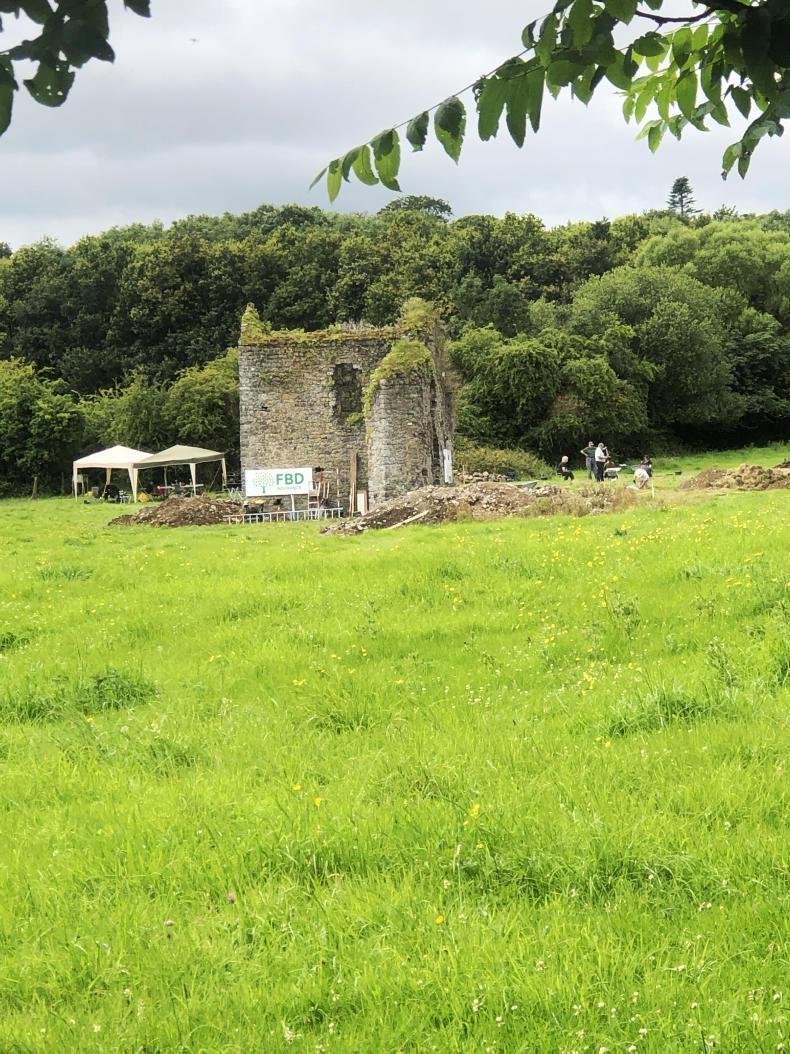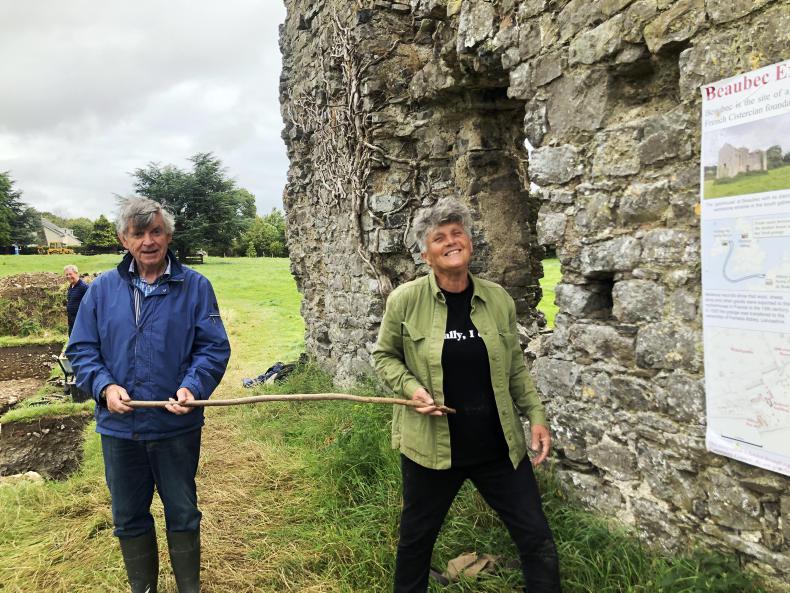There’s a stone building in the field and it’s there all my life and I’m curious about it. So I ask my aunt, ‘What is this thing?’ and she said ‘Don’t ever knock that because that was a holy site’.”
Here began a journey for Meath farmer, John McCullen, to uncover what literally lies beneath the land that his family has been farming in Beamore, Co Meath, for 200 years. Just days before the site closed for winter, in year two of three of excavations, Irish Country Living travelled to the site, “Beaubec”.

Evidence of farming, brewing and baking has been uncovered at a 13th-century monastic site in Meath.
So to answer John’s question of “What is this thing?” archaeologist Geraldine Stout explains that it is the remains of a Cistercian settlement of monks dating back to the 13th century.
Grange farms
“They were the great innovators in agriculture and farming of the medieval period, I call them ‘The Teagasc of the 13th century’,” she laughs.
But she is not wrong, in terms of innovation; they were doing crop rotations, selective breeding and had a model of farm that they basically replicated all over Europe. Worked by the lower order of monks, they lay brethren, these “grange farms” would have a very large courtyard and on either side a range of buildings.

“In the south of the grange, you always had the bakehouse, the brewhouse and the kiln. On the other side were the domestic buildings, stables and barns. The great period of agricultural production on Cistercian farms was the 13th/14th century and that’s what we have here. The system was totally self-sufficient and practiced from the 12th century right up until the 15th century.
“With archaeology sites, the story changes all the time as you get new information and you change your story based on the evidence.
“So we think that this feature here started off as the kiln but at some stage was used as a bread oven. They were drying the wheat and then they would have broken it down and used it to make bread.
Working on the site is Penny Johnston, an environmental archaeologist who identifies the seeds that are found. We asked what she had found that day – figs, elderberry, elder, raspberries, plums, beans, peas, oats and rye. This analysis gives the archaeologists an idea of what was grown in the crop rotation. For Geraldine, what’s most important in the list is the peas and beans; the proteins we no longer grow in any great quantity.
Baking bread
Geraldine’s excitement is infectious and enthuses everyone working on the site, the majority of which are volunteers.
“Fires would have heated that kiln, dried out the wheat and we think, cooked the bread as well. Every brethren got a pound loaf every day. So if we can figure out how many loaves went into that oven, we can then say how many people worked here. And we think its sourdough bread.” A nod to the current trend centuries later.

The plan and cuttings on the Beaubec site.
When queried why the kiln was in the farmyard and not in the residential area, Geraldine explains that the Cistercians thought of everything: “They always had the dangerous activities away from the residence. You find that all the dangerous activities are always together, usually in the south range. Also, this means you can plot where things are, so as the kiln and bake house are there, what’s going to be there (pointing as she jumps onto an undug piece of ground) is the brewery definitely. We will get that next year.
With that we all agree to return to sample the Beaubec beer in 12 months.

This project has been kindly sponsored by the FBD Trust.
Read more
'They’re asking for deeper, more dramatic flowers'
My Farming Week: Michael Meade, Rathbranchurch, Lobinstown, Co Meath
There’s a stone building in the field and it’s there all my life and I’m curious about it. So I ask my aunt, ‘What is this thing?’ and she said ‘Don’t ever knock that because that was a holy site’.”
Here began a journey for Meath farmer, John McCullen, to uncover what literally lies beneath the land that his family has been farming in Beamore, Co Meath, for 200 years. Just days before the site closed for winter, in year two of three of excavations, Irish Country Living travelled to the site, “Beaubec”.

Evidence of farming, brewing and baking has been uncovered at a 13th-century monastic site in Meath.
So to answer John’s question of “What is this thing?” archaeologist Geraldine Stout explains that it is the remains of a Cistercian settlement of monks dating back to the 13th century.
Grange farms
“They were the great innovators in agriculture and farming of the medieval period, I call them ‘The Teagasc of the 13th century’,” she laughs.
But she is not wrong, in terms of innovation; they were doing crop rotations, selective breeding and had a model of farm that they basically replicated all over Europe. Worked by the lower order of monks, they lay brethren, these “grange farms” would have a very large courtyard and on either side a range of buildings.

“In the south of the grange, you always had the bakehouse, the brewhouse and the kiln. On the other side were the domestic buildings, stables and barns. The great period of agricultural production on Cistercian farms was the 13th/14th century and that’s what we have here. The system was totally self-sufficient and practiced from the 12th century right up until the 15th century.
“With archaeology sites, the story changes all the time as you get new information and you change your story based on the evidence.
“So we think that this feature here started off as the kiln but at some stage was used as a bread oven. They were drying the wheat and then they would have broken it down and used it to make bread.
Working on the site is Penny Johnston, an environmental archaeologist who identifies the seeds that are found. We asked what she had found that day – figs, elderberry, elder, raspberries, plums, beans, peas, oats and rye. This analysis gives the archaeologists an idea of what was grown in the crop rotation. For Geraldine, what’s most important in the list is the peas and beans; the proteins we no longer grow in any great quantity.
Baking bread
Geraldine’s excitement is infectious and enthuses everyone working on the site, the majority of which are volunteers.
“Fires would have heated that kiln, dried out the wheat and we think, cooked the bread as well. Every brethren got a pound loaf every day. So if we can figure out how many loaves went into that oven, we can then say how many people worked here. And we think its sourdough bread.” A nod to the current trend centuries later.

The plan and cuttings on the Beaubec site.
When queried why the kiln was in the farmyard and not in the residential area, Geraldine explains that the Cistercians thought of everything: “They always had the dangerous activities away from the residence. You find that all the dangerous activities are always together, usually in the south range. Also, this means you can plot where things are, so as the kiln and bake house are there, what’s going to be there (pointing as she jumps onto an undug piece of ground) is the brewery definitely. We will get that next year.
With that we all agree to return to sample the Beaubec beer in 12 months.

This project has been kindly sponsored by the FBD Trust.
Read more
'They’re asking for deeper, more dramatic flowers'
My Farming Week: Michael Meade, Rathbranchurch, Lobinstown, Co Meath









SHARING OPTIONS